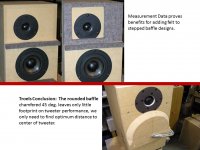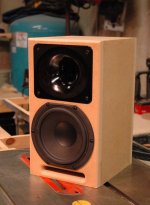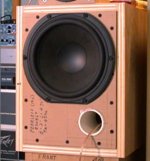That little 6" Peerless 830874 polycone is a gem, no? Cheap too! 🙂
FWIW, you have a typo on the Falcon (2013), with that 830969. It's a 830869, nest pas?
Hi Steve
Thanks for pointing out the typo. Too much work. Too little time.
The Peerless 830874 is a wonderful driver. It took me by complete surprise.
I have a friend that can give me a couple of Yamaha bookshelf in very good condition. They are sealed, something that I like. Of course, I am going to remove the drivers to use better drivers and crossovers.
The dimensions are H 16.5 x W 10.5 x D 13.2. (external dimensions inches)
Hi dvjorge
Since your Yamaha comes with drivers, maybe you can work with them first. What is the model of the speakers?
Double post but I read on your site that you were sorely dissappointed in the 8" nomex cone. How come?
1.3 cu/ft is not 31.2L. 31L is a little too big for the SS 22W Discovery but manageable (I'd prefer 25L thou), 1.3 cu/ft is definitely too big.I calculated the internal volume subtracting the MDF thickness and got a volume of 1.3 cu/ft or 31.20 L
If you plan to use a different driver than the SS Discovery then simulate it with Unibox.Most of the 8" drivers I have seen recommend an 0.5 or 0.75 cu/ft for a sealed enclosure. My question is if I can use this boxes to build my project.
Ralf
I see you also used 20l enclosure. What are the tuning and port dimensions you used?
Fb=45Hz
Port Dia=2"
Length = 4.7"
Double post but I read on your site that you were sorely dissappointed in the 8" nomex cone. How come?
I expected more from an expensive driver. My main gripe is the 830869 is too polite. Due to it's flatness, the midrange doesn't stand out. Sounds like some ceiling speakers in shopping malls. Even a JBL2324/2425 couldn't breathe life to it.
I then tried a 3-way using a Dayton RS-52AN for the mids. Now the mids shine but it revealed another weakness, the bass. It's too lame for my liking.
I like bass to be dynamic. The 830869 just doesn't have the attack in the mid-bass. Compared to my Usher 8137, the 830868 is like an "old man". SLOOOOW.
Don't be mistaken, the 830869 has it's strength. I think it is designed for easy listening. If you're happy with how speakers sound in the 80s, the 830869 fits the bill perfectly.
I'm still scratching my head on what to do with my 830869. I always try to find something outstanding with drivers that I work on but with this 830869, it's still a "plain Jane". Maybe I'll have a Eureka moment one day.
Interesting. I also have the Peerless 830868 PPB driver and The ScanSpeak 22W/8534G00 which all basically do the same thing. Let's see what fits best with the SB26ADC-4.
Interesting. I also have the Peerless 830868 PPB driver and The ScanSpeak 22W/8534G00 which all basically do the same thing. Let's see what fits best with the SB26ADC-4.
I will love to know your results before to buy some of them.
These cabinets are great for an 8" + 1" two way.The dimensions are H 16.5 x W 10.5 x D 13.2. (external dimensions inches) I calculated the internal volume subtracting the MDF thickness and got a volume of 1.3 cu/ft or 31.20 L
My question is if I can use these boxes to build my project.
Sealed 0.74cuft (21 l) net volume cabinet has Qtc=0.7
Sealed 1.2cuft (34 l) net volume cabinet has Qtc=0.6
Both sizes will generate great transient bass. Some listeners favor the slightly extra damped transients from the Qtc=0.6. You can easily reduce internal volume by adding wood blocks.
With a 1.2cuft (34 l) net volume cabinet you have the option of including a port tuned to 38Hz which produces -F3=44Hz for stand alone performance, or plugging the full port volume to get a great performing sealed Qtc between 0.6 and 0.7.
Fantastic to get LR4 with so little components!
Will also try stepped baffle for physical time alignment.
Standard LR4/LR4 circuits requires: 4L + 4C + 1R = 9 components
chazdrumzalot acoustic LR4 requires: 4L + 3C + 3R = 10 components + waveguide
Attachments
These cabinets are great for an 8" + 1" two way.
Sealed 0.74cuft (21 l) net volume cabinet has Qtc=0.7
Sealed 1.2cuft (34 l) net volume cabinet has Qtc=0.6
Both sizes will generate great transient bass. Some listeners favor the slightly extra damped transients from the Qtc=0.6. You can easily reduce internal volume by adding wood blocks.
With a 1.2cuft (34 l) net volume cabinet you have the option of including a port tuned to 38Hz which produces -F3=44Hz for stand alone performance, or plugging the full port volume to get a great performing sealed Qtc between 0.6 and 0.7.
Thank you so much for your help.
I made a mistake converting cubit inches to liters since I used an online calculator that converted it to quarts (no liters) I did it again using the right converter to know the internal volume of the Yamaha enclosures and they are 36.8 liters. After your suggestion, I did some calculations and got that adding one piece of 10.75"x 4"x 4" I am reducing the internal volume 2.8L, so the internal volume will be 34L = 1.2 cu/ft. I am very enthusiastic with all this idea and appreciate all the help. I think I will use these Yamaha enclosures because they are mint. Now, I have to decide what drivers and crossovers. Scan Speak and Peerless are what I have seen so far. The Peerless are $60.00 less than the SS, if I go for them, I can spend more on tweeters and crossovers.
I made a mistake converting cubit inches to liters since I used an online calculator that converted it to quarts (no liters) I did it again using the right converter to know the internal volume of the Yamaha enclosures and they are 36.8 liters.
Use the full 36.8 liters, your speakers and crossover and ?port? will take up some volume ... so first listen and measure the full 36.8-l, many people favor the tighter transients from a slightly lower Qtc which comes from a slightly larger volume. Give some thought to the "pluggable port" idea.
Do you think adding a cabinet cross brace would be useful? easy??
Use the full 36.8 liters, your speakers and crossover and ?port? will take up some volume ... so first listen and measure the full 36.8-l, many people favor the tighter transients from a slightly lower Qtc which comes from a slightly larger volume. Give some thought to the "pluggable port" idea.
Do you think adding a cabinet cross brace would be useful? easy??
Yes, adding a cross brace will reinforce the cabinets. Any piece of wood I may add to the interior, can be done as a cross brace. The thing with the pluggable port is these speakers are sealed, so I will have to add the ports. I have no problem to do it if I know the right length and diameter. Thanks again.!
Not sure this has been linked yet, looks a nice simple design with good frequency curve.
LA BELLE CR | Visaton
Not the cheapest drivers though.
LA BELLE CR | Visaton
Not the cheapest drivers though.
There is a much better reference for the stuffing of speaker box by Ken Kantor.
Ken Kantor was the founder and original designer of the NHT line of speakers.
I built 4 bookshelfs using the Peerless 830875 Nomax drivers. I am somewhat familiar with the Peerless Nomax driver's design philosophy. Your comment on the 830869 is very interesting. I suspect that that the 830869 is NOT too slow, but it is too fast to damp out the ringing in mid bass making it sound less boomy. If it was designed to be flat and neutral sounding to be accurate, which all genre of music needs. It may not be for easy listening as you suggested.I expected more from an expensive driver. My main gripe is the 830869 is too polite. Due to it's flatness, the midrange doesn't stand out. Sounds like some ceiling speakers in shopping malls. Even a JBL2324/2425 couldn't breathe life to it.
I then tried a 3-way using a Dayton RS-52AN for the mids. Now the mids shine but it revealed another weakness, the bass. It's too lame for my liking.
I like bass to be dynamic. The 830869 just doesn't have the attack in the mid-bass. Compared to my Usher 8137, the 830868 is like an "old man". SLOOOOW.
Don't be mistaken, the 830869 has it's strength. I think it is designed for easy listening. If you're happy with how speakers sound in the 80s, the 830869 fits the bill perfectly.
I'm still scratching my head on what to do with my 830869. I always try to find something outstanding with drivers that I work on but with this 830869, it's still a "plain Jane". Maybe I'll have a Eureka moment one day.
I have not used the 830869. But I know that the 830875 Nomax driver is NOT suitable for punchy mid bass. I used them in a 0.5 cuft closed box. The bass rolls off quite early, but the mid bass is very tight and well controlled. I cross it over to a pair of aperiodic subwoofers at 120 Hz.
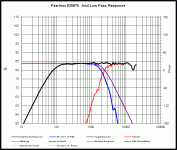
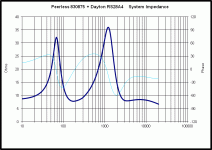
Last edited:
The thing with the pluggable port is these speakers are sealed, so I will have to add the ports. I have no problem to do it if I know the right length and diameter.
Naturally, you can test your new speakers + crossover in the sealed enclosure first.
============
"The dimensions are H 16.5 x W 10.5 x D 13.2. (external dimensions inches)
the internal volume of the Yamaha enclosures are 36.8 liters"
==============
For decent -F3=48Hz bass from a ported alignment ---- which can plugged
1) add some cross bracing, at least one vertical and one horizontal to divide the panel resonance
2) If you plan to put these speakers in a bookcase or against the rear wall, the port should be on the front baffle
--- for this modest 16.5" high baffle, locate the port bottom-off-center to use the speaker-arc for extra separation
3) If you plan to keep these speakers "a couple feet" from the rear wall, the port can be put on the rear panel
--- locate the port hole behind the tweeter
5) for -F3=48Hz tune the port to 32Hz with a 2" interior diameter SCH40 pipe 4.6" long
----measure the internal diameter of your local PVC pipe...IF NOT 2" we can re-calculate port length
6) on scrap wood, practice cutting a port hole and test fit your PVC pipe before you work on the cabinets. TIGHT is good.
--- do not glue in the port until after listening and measurement
7) With the port plugged you will get well controlled transients from Qtc=0.6 alignment. -F3 = 70Hz before any room gain
Attachments
The Nomex is just the cone material. I don't think your 830875 has the same character as the 830869 even though both have Nomex cones. If you have the chance to work on a 830869, I'll be interested to know your impressions.I am somewhat familiar with the Peerless Nomax driver's design philosophy. Your comment on the 830869 is very interesting. I suspect that that the 830869 is NOT too slow, but it is too fast to damp out the ringing in mid bass making it sound less boomy. If it was designed to be flat and neutral sounding to be accurate, which all genre of music needs. It may not be for easy listening as you suggested.
Regarding your 830875, I believe it sounds similar to my 830874. If I'm not mistaken, they are essentially the same drivers but one with Nomex while the other uses Polypropylene cone.
I don't have the 830875 but I have no issues with the mid-bass with my 830874. Fast and tight mid-bass.But I know that the 830875 Nomax driver is NOT suitable for punchy mid bass. I used them in a 0.5 cuft closed box. The bass rolls off quite early, but the mid bass is very tight and well controlled. I cross it over to a pair of aperiodic subwoofers at 120 Hz.
I have two time-aligned speakers using the 830874. One is a bass reflex ( Cardinal-TA ) while the other is a Dual Chamber Reflex ( Cardinal-DCR-TA ).
I am very satisfied by how they sound. If only the 830869 is like the 830874, it will make my dream come true.
What is your definition of "time aligned"? I went to the links you cited. Those speakers are not physically time aligned. And the posts on them have no technical information such as cabinet alignment, crossover schematics whatsoever. The post tells the visitor nothing about the speakers. I was really impressed by the list of speakers you built, but the posts are utter disappointment because there is no sharing of information.I have two time-aligned speakers using the 830874. One is a bass reflex ( Cardinal-TA ) while the other is a Dual Chamber Reflex ( Cardinal-DCR-TA ).
I am very satisfied by how they sound. If only the 830869 is like the 830874, it will make my dream come true.
Your assessment of the Peerless 830869 seems to have changed over the years. In the 2012-13 time frame, you had several system built around the 830869. Were the old version faster?
Last edited:
Calm down.. it doesnt mention physical time alignment and just maybe he wants to build speakers not using the same woofer every time.What is your definition of "time aligned"? I went to the links you cited. Those speakers are not physically time aligned. And the posts on them have no technical information such as cabinet alignment, crossover schematics whatsoever. The post tells the visitor nothing about the speakers. I was really impressed by the list of speakers you built, but the posts are utter disappointment because there is no sharing of information.
Your assessment of the Peerless 830869 seems to have changed over the years. In the 2012-13 time frame, you had several system built around the 830869. Were the old version faster?
If you read the whole entry it says clearly
"Crossover Values & Box Dimensions
If you’re interested to build this project, kindly send me a mail for the crossover and box dimensions. For non-commercial use only."
What is your definition of "time aligned"? I went to the links you cited. Those speakers are not physically time aligned. And the posts on them have no technical information such as cabinet alignment, crossover schematics whatsoever.
In HiFi speakers, Time Alignment is normally depicted as using a step for the woofer or by tilting the front panel. I think this is what you meant by physical time alignment.
But this is not alway necessary. If the acoustic centers of the tweeter and the woofer is correct, no step or tilting is required. It can be done strictly by the crossover.
That is why only a few of my designs are Time-Aligned. For those whose acoustic centers are not conducive, I will have to resort to using a step.
The easiest way is to do it electronically. No step or tilting. Just add delay to either the woofer or the tweeter. This is what I did to the Faitalpro STH100 with a Selenium D220ti and a Dayton RS180s.
The post tells the visitor nothing about the speakers. I was really impressed by the list of speakers you built, but the posts are utter disappointment because there is no sharing of information.
As Bill pointed out, simply send me a mail and I'll be more than happy to share my crossovers and box dimensions. I have requests from all parts of the world and diyers are very appreciative and grateful that I share them freely. It is all done in the spirit of DIY.
Your assessment of the Peerless 830869 seems to have changed over the years. In the 2012-13 time frame, you had several system built around the 830869. Were the old version faster?
I was being polite. Manufacturers invest money in making their products. A bad review can affect sales. I am always mindful of that.
Moreover, there's also a question of my expectations. There are certain things I want from an 8" which the 830869 doesn't have. That is not to say it is a bad driver. Actually, it is a very good woofer. Just doesn't do what I have in mind. Maybe I'll try it in a bandpass sub. Sounds silly but you never know. That's the fun of diy 🙂
Have a Merry Christmas.
I have two time-aligned speakers using the 830874. One is a bass reflex ( Cardinal-TA ) while the other is a Dual Chamber Reflex ( Cardinal-DCR-TA ).
Since nothing was mention in your post, I assume that "time alignment" for ( Cardinal-TA ) and ( Cardinal-DCR-TA ) were done by adding delay to either the woofer or the tweeter electronically. Even if you do not want to share the detail of the electronic crossover, a block diagram will be very helpful in your post in the spirit of DIY.In HiFi speakers, Time Alignment is normally depicted as using a step for the woofer or by tilting the front panel. I think this is what you meant by physical time alignment.
But this is not alway necessary. If the acoustic centers of the tweeter and the woofer is correct, no step or tilting is required. It can be done strictly by the crossover.
That is why only a few of my designs are Time-Aligned. For those whose acoustic centers are not conducive, I will have to resort to using a step.
The easiest way is to do it electronically. No step or tilting. Just add delay to either the woofer or the tweeter. This is what I did to the Faitalpro STH100 with a Selenium D220ti and a Dayton RS180s.
I would love to know whether you implement the delay using active or passive circuit which was not mentioned. A passive time delay circuit enough to compensate the offset in Cardinal-TA or Cardinal-DCR-TA speaker will be a ground breaking development. BTW, the nulling at the crossover frequency when the drivers were connected out of phase is NOT a indication of "time aligned". I will appreciate a correction if I am wrong on this point.
While this DIY speaker hobby is not a technical journal that required peer reviews, I believe in an open forum for DIY where design and opinion are subjected to critique and correction.
Last edited:
- Home
- Loudspeakers
- Multi-Way
- Building a two way bookshelf
